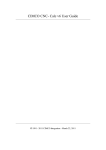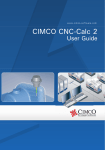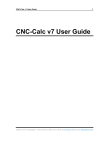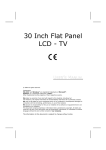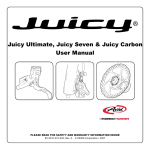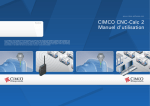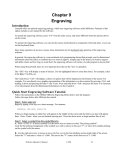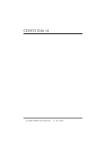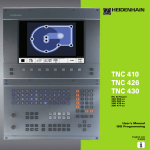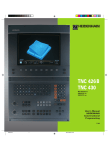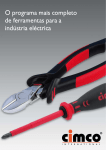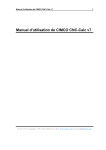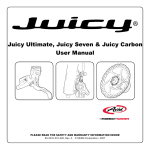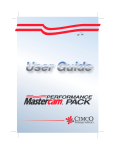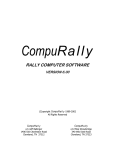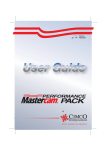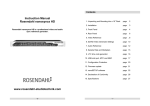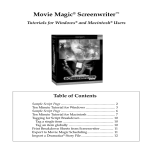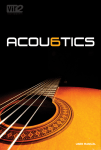Download CIMCO CNC-Calc 2 - User Guide with tutorials 1-10
Transcript
1 2 3 CIMCO CNC-Calc 2.5 User Guide © 1991 - 2010 CIMCO Integration - May 14, 2010 4 5 2. License information Information in this document is subject to change without notice and does not represent a commitment on the part of CIMCO Integration. The software described in this document may be used or copied only in accordance with the terms of the license. The purchaser may make one copy of the software for a backup, but no part of this user manual may be reproduced, stored in a retrieval system, or transmitted in any form or by any means electronic or mechanical, including photocopying and recording for any purpose other than the purchaser’s personal use, without prior written permission from CIMCO Integration. TERMS OF USE FOR: Software: CNC-Calc v2 Version: 2.x.x Date: January 2010 Copyright (c) 2010 by CIMCO Integration Notice: CIMCO Integration reserves the right to make changes to the CNC-Calc v2 Software at any time and without notice. Software License You have the right to use the number of licenses of the enclosed program, which you have bought from CIMCO Integration. You may not distribute copies of the program or related documentation to any persons or companies. You may not modify the program or related documentation without the prior written consent of CIMCO Integration. Disclaimer of all Warranties and Liability CIMCO Integration makes no warranties, either express or implied, with respect to the software, its quality, performance, merchantability, or fitness for any particular purpose. The entire risk as to its quality and performance is with the buyer. Should the CNC-Calc v2 software prove defective following its purchase, the buyer (and not CIMCO Integration, its distributor, or its retailer) assumes the entire cost of all necessary servicing, repair, of correction and any incidental or consequential damages. In no event will CIMCO Integration be liable for direct, indirect, or consequential damages resulting from any defect in the software, even if CIMCO Integration has been advised of the possibility of such damages. Some jurisdictions do not allow the exclusion or limitation of implied warranties or liability for incidental or consequential damages, so the above limitation or exclusion may not apply to you. 6 Notice: The accompanying software is confidential and proprietary to CIMCO Integration. No use or disclosure is permitted other than as expressly set forth by written license with CIMCO Integration. Copyright (c) 2010 CIMCO Integration. All rights reserved. THIS SOFTWARE CONTAINS CONFIDENTIAL INFORMATION AND TRADE SECRETS OF CIMCO INTEGRATION. USE, DISCLOSURE, OR REPRODUCTION IS PROHIBITED WITHOUT THE PRIOR EXPRESS WRITTEN PERMISSION OF CIMCO INTEGRATION. The CIMCO Logo is a trademark of CIMCO Integration. Microsoft, Windows, and Windows NT are registered trademarks of Microsoft Corporation. Other brand and product names are trademarks or registered trademarks of their respective holders. Contacting CIMCO Integration Address: CIMCO Integration I/S Lundtoftegaardsvej 97, 3. DK-2800 Lyngby Denmark Phone: +45 4585 6050 Fax: +45 4585 6053 E-mail: [email protected] Web: http://www.cimco-software.com 7 8 3. Table of Content 4. Installation 9 5. Overview 10 6. Mouse functions 12 7. Toolbars 13 8. Menus 23 9. Configuring CNC-Calc 32 10. Color configuration 36 11.Other configurations that affect CNC-Calc 37 Milling tutorials 12.Tutorial 1 2D Construction 38 13.Tutorial 2 CNC-toolpaths and Face milling 48 14.Tutorial 3 Contour milling 57 15.Tutorial 4 Pocket milling 67 16.Tutorial 5 Backplot in the Editor 77 17.Tutorial 6 Drilling 84 18.Tutorial 7 Milling of Letters 89 19.Tutorial 8 Milling of TrueType Letters 96 Turning tutorials 20.Tutorial 9 Drawing the part 105 21.Tutorial 10 Machining the part 119 9 4. Installation CNC-Calc v2 is installed as part of CIMCO Edit v5. Please see the CIMCO Edit v5 documentation for installation instructions. If you are upgrading an existing installation without CNC-Calc v2 you do not need to reinstall CIMCO Edit v5. Just copy the new keyfile (named “license.key”) to the appropriate directory. 10 5. Overview CNC-Calc v2 can draw 2D geometry, and generate NC code in ISO and Heidenhain conversational format for contours and drilling cycles. The main program window looks like this (with an empty drawing pane): The toolbars can be arranged as desired by dragging them around. They can be docked along any edge of the program window, in any order, or they can be placed floating on top of the program window or outside the program window. To the left of the drawing pane, you see the CNC-Calc and Element Inf o panes. The CNC-Calc pane shows coordinate entry fields and other information about the activity you are performing at any given time, while the Element Info pane shows the statistics of the element you are hovering the mouse over. To the right, you can see an example of the Element Info pane display. 11 Most of the functions in CNC-Calc v2 can be accessed through toolbars and the CNCCalc menu, though a few functions are accessed in the File menu in CIMCO Edit v5 . The following sections will first describe the mouse functions, then the toolbars and menus. 12 6. Mouse functions The mouse buttons are used to perform the following functions: Left button Selects whatever is described in the lower left corner of the program window. Middle button (on most mice, pressing the scroll wheel) Fits/zooms the geometry drawing to the entire graphics area. This can also be achieved by clicking the icon. Right buttonDrag the geometry drawing across the graphics area by holding down the right mouse button as you drag the mouse. Scroll wheel Zoom in and out, centered on the cursor position. 13 7. Toolbars 7.1. Tool The Tools toolbar handles file operations, toolpath functions, zoom, snap and configuration access. The functions in the Tools toolbar are also available from the CNC-Calc menu. New Drawing clears the graphics area (you will get a chance to save any unsaved changes). This can also be accessed with Ctrl N. Open Drawing opens existing CNC-Calc v2 or DXF files. This can also be accessed with Ctrl O. The downwards arrow next to the open icon gives access to a recent files list, making it easy to reopen a file which you have been editing recently. Save saves the drawing to your hard disk. If it is the first time you save the drawing, you will be prompted for a file location and name. Save can also be accessed with Ctrl S. Zoom in centered on the middle of the graphics area. Zoom in can also be accessed with Page Down. Zoom out centered on the middle of the graphics area. Zoom out can also be accessed with Page Up. Zoom All fits the drawing to the graphics area. This can also be done by clicking the middle button on the mouse (on most mice, pressing the scroll wheel), or with Ctrl-End. Zoom Window lets you zoom in on an area, which you select by first clicking at one corner, then dragging the rectangle and clicking at the opposite corner. 14 Snap to Grid snaps to the grid points. Snap to Points snaps to points drawn by the user. Snap to Center Points snaps to the centers of circles and arcs. Snap to Mid points snaps to the midpoints of elements. Snap to Mid points snaps to the midpoints of elements. Snap to Intersections snaps to the intersections between elements. Enable All Snap Types activates all snap types. Disable All Snap Types deactivates all snap types. Setup CNC-Calc lets you access the configuration for CNC-Calc. 7.2. Points and Lines The Points/Lines toolbar contains functions for drawing lines and points defined in different ways. The functions in this toolbar can be found under Draw Points/Lines in the menu. Setup CNC-Calc lets you access the configuration for CNC-Calc. Between 2 Points will draw a line between two selected points. Vertical will draw a vertical line. The first point selected defines the starting point (and the X coordinate), the second point selected defines the length (and need not be directly above or below the first point). 15 Horizontal will draw a horizontal line. The first point selected defines the starting point (and the Y coordinate), the second point selected defines the length (and need not be directly to the left or right of the first point). Polar lets you select the starting point of a line, and you then select (or write) the angle and length of the line. Perpendicular draws a line perpendicular to another line. You first select the line your new line is to be perpendicular to, then the starting point of your new line. You then select the length of your new line, and last you select in which direction from the starting point your new line is to go. Parallel draws a line parallel to another line. You first select the line your new line is to be parallel to, then the starting point of your new line. You then select the length of your new line, and last you select in which direction from the starting point your new line is to go. Bisector draws a line bisecting two other lines, i.e. a line that halves the angle between two lines. You first select the two lines you want to bisect, then you select the length of your new line (from the intersection of the two lines you are bisecting), and last you select which of the four possible solutions you want to keep. Tangent Two Elements lets you draw a line tangent to two circles or arcs. You select the two circles or arcs your new line is to be tangent to, and then you select which of the solutions you want to keep. Tangent Angle draws a line tangent to an arc or circle, at a selected angle. You first select the arc or circle your new line is to be tangent to, then the angle and length, and last you select which of the two solutions you want to keep. Tangent Through Point draws a line tangent to an arc or circle, to a selected point. You first select the arc or circle your new line is to be tangent to, then the point it is to go though, and last you select which of the two solutions you want to keep. 16 Rectangle draws a rectangle where you select the two opposite corners. It is possible to define a corner radius for the rectangle (the corner radius is ignored if there is not room for it). 7.3. Arcs and Circles The Arcs/Circles toolbar lets you draw full circles (360 degree arcs), arcs and bolt patterns. The functions in the Arcs/Circles toolbar can be found under Draw Arcs / Circles and Draw Special in the menu. Center Radius lets you define the center of the circle, followed by the radius. Two Points lets you define the circle by selecting two (diametrically opposite) points. Three Points lets you define the circle by selecting three points on the periphery of the circle. Center Diameter lets you define the center of the circle, followed by the diameter. Tangent Two Elements lets you define a circle tangent to two elements, of a defined radius. You first write the radius, then you select the two elements the circle is to be tangent to. Last you select which of the solutions you want to keep. Tangent Center on Line lets you define a circle tangent to one element, with its center on a line, of a defined radius. You first write the radius, then you select the line the center is to be on, and the element the circle is to be tangent to. Last you select which of the solutions you want to keep. 17 Tangent through Point lets you define a circle tangent to one element, through a point, of a defined radius. You first select the point the circle is to go through then write the radius, and select the element the circle is to be tangent to. Last you select which of the solutions you want to keep. Tangent Three Elements defines a circle tangent to three elements. You select the three elements the circle is to be tangent to, and then you select which of the solutions you want to keep. Two Points lets you draw an arc by selecting the endpoints of the arc, entering the radius, and selecting which solution you want to keep. Three Points lets you draw an arc by selecting three points. Note, that the arc created will not cross the zero degree point (3 o’clock); The order the three points are selected in does not matter. Start and End Angles lets you define an arc by its center point, radius, starting angle and end angle. Rectangular Bolt Hole Pattern defines a rectangular bolt pattern. You select the start point (one of the corners), and then enter the step in X, step in Y, number of holes in X, number of holes in Y and the hole diameter. Circular Bolt Hole Pattern defines a circular bolt pattern. You select the center of the bolt pattern, select the radius of the bolt pattern, and then enter the start angle, step angle, number of holes and the hole diameter. 18 7.4. Letters The Letters toolbar lets you draw two kinds of letters; simple letters and True Type letters. The simple letters are like the letters used on drawings. These letters can be used to mill, for instance, a part number on a part. The True Type letter is more artistic, and any True Type font installed in the Windows operating system can be used. The Letters toolbar can be found under Draw Arcs / Circles and Draw Special in the menu. Simple Text Linear Alignment defines simple text written on a line. You enter the starting point, angle of the line, then the distance between and height of the letters. It is also possible to select the horizontal and vertical alignment of the text. Simple Text Circular Alignment defines simple text that is written on a circle. You select or enter the center and radius of the alignment circle, then the start angle, space between and height of the letters. It is also possible to select the horizontal and vertical alignment of the text, on the circle. True Type Text Linear Alignment defines True Type text written on a line. You enter the starting point and angle of the line, and then the height of the letters. It is also possible to select the horizontal and vertical alignment of the text. True Type Text Circular Alignment defines True Type text that is written on a circle. You select or enter the center and radius of the alignment circle, then the start angle and height of the letters. It is also possible to select the horizontal and vertical alignment of the text, on the circle. 19 7.5. Modify The Modify toolbar modifies the geometry in different ways. The functions in the Modify toolbar can be found under Modify in the menu. Trim To Intersection will trim the selected element to the nearest intersection(s). Select the element to be trimmed on that part to be removed; It is then trimmed to the intersection(s) nearest the point where it was selected. The trimmed element is also broken in two, if there are intersections on both sides of the selected point. Trim One Element will trim one element to another. Select the element to be trimmed first, on the side to be kept, and then select the element to trim to. Trim Two Elements will trim two elements to each other. Select the two elements to be trimmed, on the side to be kept. Fillet Elements creates a fillet between two elements, with a fillet radius the user selects. It is optional whether the two elements should also be trimmed to the fillet. Break Elements will divide an element into two pieces. First select the element to be broken into two, and then select the point at which it should be divided. Join Elements will join two selected elements into one. Delete will delete the elements you select. They can be restored with the Undo function (the icon or Undo under Modify in the menu. Offset Elements will offset the elements you select by a specified distance. It is optional whether the original element should be kept. 20 Mirror Elements will mirror the elements you select about a line selected as the mirror axis. Translate Elements will translate the elements you select along a vector defined by selecting two points. It is optional whether the original should be kept, and it is possible to create multiple copies, where each copy is translated one step further along the selected vector. Rotate Elements will create one or more copies of the selected elements, rotated around a selected point, at a specified angle per copy. It is optional whether the original should be kept. Scale Elements will create one or more copies of the selected elements, scaled about a selected point by a specified scale factor. It is optional whether the original should be kept. Undo will undo one or more operations. This can mean deleting elements created, restoring deleted elements, and/or undoing modifications to elements. Undo can also be accessed with CtrlBackspace. 7.6. Milling The Milling toolbar allows the user to perform various operations used in the manufacturing of parts. All the operation can be exported directly to CIMCO Edit or to the clipboard, for insertion in a user defined location. The functions in the Milling toolbar are also found under Milling operations in the menu. Face Milling creates a facing operation based on a selected outline contour. 21 Pocket Milling creates pocket operations for one or multiple pockets. These pockets can contain none or multiple islands. In a single operation, it is possible to make both roughing and finishing cuts, but only with one tool. Contour Milling creates operations for contour milling. A contour operation can machine multiple contours with roughing and finishing cuts, but only with one tool. Drilling creates drilling operations for hole drilling. From a drawing the hole positions can be selected with the use of a filter, or by simply indicating the hole position. If multiple holes are drilled, they can be arranged in both rectangular and circular patterns. Helix Milling can generate operations for helix drilling. Like normal drilling, multiple holes can be selected with the use of filters, or by selecting the individual circles on the drawing. Thread Milling can create threading milling operations. The threads can be inside or outside, and can be created for tools with one or multiple teeth. Again multiple threads can easily be selected with the use of the filter function. Simple letter milling can generate operations for milling simple letters on the drawing. These letters will have to be drawn using the simple letter function, but then all letters can be selected with the window functions, and machined in operations based on their start and end depth. True Type letter milling can create operations to mill the outline and/ or the interior of the individual letters. The letters can be selected with the window function, and all letters with the same parameters can be machined in one operation. 22 Export Contour can export a contour that the operator has selected on the drawing. If a controller have smart canned cycles for example a specific pocket operation, the user can create a macro in the editor to support this, and then export the actual contour for insertion in the canned cycle. Feed and Speed Calculator is used to generate tool changes, or to simply calculate the feed and speed, based on the data of a specific tool. 23 8. Menus Most of the CNC-Calc v2 functions are accessed through the CNC-Calc menu, however, the following functions are accessed through the File menu. 8.1. File menu CloseCloses the active file. If the active file has been modified, then the user will be prompted to save it. Close can also be accessed with Ctrl-F4. Close All Closes all open files. If any files have been modified, then the user will be prompted to save them. SaveSaves the drawing to your hard disk. If it is the first time you save the drawing, you will be prompted for a file location and name. Save can also be accessed with Ctrl S. Save As Saves the drawing under a different name. ExitCloses CIMCO Edit v5, and thus also CNC-Calc v2. If any files have been modified, then the user will be prompted to save them. Exit can also be accessed with Alt F4 (Alt F4 is a Windows standard). 8.2. CNC-Calc menu New Drawing Clears the graphics area (you will get a chance to save any unsaved changes). New can also be accessed with Ctrl N. Open Drawing Opens an existing CNC-Calc v2 file. Open can also be accessed with Ctrl O. 24 8.2.1. Draw Points / Lines Point Draws a point at the selected position Between 2 points Draws a line between the two selected points. Vertical Draws a vertical line. The first point selected defines the starting point (and the X coordinate), the second point selected defines the length (and need not be directly above or below the first point). Horizontal Draws a horizontal line. The first point selected defines the starting point (and the Y coordinate), the second point selected defines the length (and need not be directly to the left or right of the first point). Polar Lets you select the starting point of a line, and you then select (or write) the angle and length of the line. Perpendicular Draws a line perpendicular to another line. You first select the line your new line is to be perpendicular to, then the starting point of your new line. You then select the length of your new line, and last you select in which direction from the starting point your new line is to go. Parallel Draws a line parallel to another line. You first select the line your new line is to be parallel to, then the starting point of your new line. You then select the length of your new line, and last you select in which direction from the starting point your new line is to go. Bisector Draws a line bisecting two other lines, i.e. a line that halves the angle between two lines. You first select the two line you want to bisect, then you select the length of your new line (from the intersection of the two lines you are bisecting), and last you select which of the four possible solutions you want to keep. Tangent Two Elements Lets you draw a line tangent to two circles or arcs. You select the two circles or arcs your new line is to be tangent to, and then you select which of the solutions you want to keep. 25 Tangent Angle Draws a line tangent to an arc or circle, at a selected angle. You first select the arc or circle your new line is to be tangent to, then the angle and length, and last you select which of the two solutions you want to keep. Tangent Through Point Draws a line tangent to an arc or circle, to a selected point. You first select the arc or circle your new line is to be tangent to, then the point it is to go though, and last you select which of the two solutions you want to keep. Rectangle Draws a rectangle where you select the two opposite corners. It is possible to define a corner radius for the rectangle (the corner radius is ignored if there is not room for it). 8.2.2. Draw Arcs / Circles Two PointsLets you define the circle by selecting two (diametrically opposite) points. Three Points Lets you define the circle by selecting three points on the periphery of the circle. Center Radius Lets you define the center of the circle, followed by the radius. Center Diameter Lets you define the center of the circle, followed by the diameter. Tangent Two ElementsLets you define a circle tangent to two elements, of a defined radius. You first write the radius, then you select the two elements the circle is to be tangent to. Last you select which of the solutions you want to keep. Tangent Three Elements Defines a circle tangent to three elements. You select the three elements the circle is to be tangent to, and then you select which of the solutions you want to keep. Tangent Center on Line Lets you define a circle tangent to one element, with its center on a line, of a defined radius. You first write the radius, then 26 you select the line the center is to be on, and the element the circle is to be tangent to. Last you select which of the solutions you want to keep. Tangent through Point Lets you define a circle tangent to one element, through a point, of a defined radius. You first select the point the circle is to go through then write the radius, and select the element the circle is to be tangent to. Last you select which of the solutions you want to keep. Two Points Lets you draw an arc by selecting the endpoints of the arc, entering the radius, and selecting which solution you want to keep. Three Points Lets you draw an arc by selecting three points. Note, that the arc created will not cross the zero degree point (3 o’clock); The order the three points are selected in does not matter. Start and End Angles Lets you define an arc by its center point, radius, starting angle and end angle. 8.2.3. Draw Special Rectangular Bolt Hole Pattern Defines a rectangular bolt pattern. You select the start point (one of the corners), and then enter the step in X, step in Y, number of holes in X, number of holes in Y and the hole diameter. Circular Bolt Hole Pattern Defines a circular bolt pattern. You select the center of the bolt pattern, select the radius of the bolt pattern, and then enter the start angle, step angle, number of holes and the hole diameter. Simple Text Linear Alignment Defines simple text written on a line. You enter the start point, angle of the line, then the distance between and height of the 27 letters. It is also possible to select the horizontal and vertical alignment of the text. Simple Text Circular Alignment Defines simple text that is written on a circle. You select or enter the center and radius of the alignment circle, then the start angle, space between and height of the letters. It is also possible to select the horizontal and vertical alignment of the text, on the circle. True Type Text Linear Alignment Defines True Type text written on a line. You enter the start point and angle of the line, and then the height of the letters. It is also possible to select the horizontal and vertical alignment of the text. True Type Text Circular Alignment Defines True Type text that is written on a circle. You select or enter the center and radius of the alignment circle, then the start angle and height of the letters. It is also possible to select the horizontal and vertical alignment of the text, on the circle. 8.2.4. Modify Trim To Intersection ill trim the selected element to the nearest intersection(s). W Select the element to be trimmed on that part to be removed; it is then trimmed to the intersection(s) nearest the point where it was selected. The trimmed element is also broken in two, if there are intersections on both sides of the selected point. Trim One Element Will trim one element to another. Select the element to be trimmed first, on the side to be kept, and then select the element to trim to. 28 Trim Two Elements ill trim two elements to each other. Select the two elements W to be trimmed, on the side to be kept. Fillet Elements Creates a fillet between two elements, with a fillet radius the user selects. It is optional, whether the two elements should also be trimmed to the fillet. Break Elements Will divide an element into two pieces. First select the element to be broken into two, and then select the point at which it should be divided. Join Elements Will join two selected elements into one. The two elements have to elements that can be joined into one element, of course. Delete Will delete the elements you select. They can be restored with the Undo function (the icon or Undo under Modify in the menu. Offset Will offset the elements you select by a specified distance. It is optional whether the original should be kept. Mirror Elements will mirror the elements you select about a line selected as the mirror axis. Translate Elements Will translate the elements you select along a vector defined by selecting two points. It is optional whether the original should be kept, and it is possible to create multiple copies, where each copy is translated one step further along the selected vector. Rotate Elements Will create one or more copies of the selected elements, rotated around a selected point, at a specified angle per copy. It is optional whether the original should be kept. Scale Elements Will create one or more copies of the selected elements, scaled about a selected point by a specified scale factor. It is optional whether the original should be kept. Undo Will undo one or more operations. This can mean deleting elements created, restoring deleted elements, and/or undoing modifications to elements. Undo can also be accessed with 29 Ctrl- Backspace. Zoom in Centered on the middle of the graphics area. Zoom in can also be accessed with Page Down. Zoom out Centered on the middle of the graphics area. Zoom out can also be accessed with Page Up. Zoom All Will fit the drawing to the graphics area. This can also be done by clicking the middle button on the mouse (on most mice, pressing the scroll wheel), or with Ctrl-End. Zoom Window Lets you zoom in on an area, which you select by first clicking at one corner, then dragging the rectangle and clicking at the opposite corner. Snap to Grid Snaps to the grid points. Snap to Points Snaps to points drawn by the user. Snap to Center points Snaps to the centers of circles and arcs. Snap to Mid points Snaps to the midpoints of elements. Snap to End points Snaps to the endpoints of elements. Snap to Intersections Snaps to the intersections between elements. Enable All Snap Types Activates all snap types. Disable All Snap Types Deactivates all snap types. Layout Toolpath Lets you chain a toolpath contour, and then export it as ISO or Heidenhain Conversational NC code. Drill Holes Lets you select drill points and a drill cycle, and then export it as ISO or Heidenhain Conversational NC code. Setup CNC-Calc Lets you access the configuration for CNC-Calc. 30 8.2.5. Milling Operations Face Milling Creates a facing operation based on a selected outline contour. Pocket Milling Creates pocket operations for one or multiple pockets. These pockets can contain none or multiple islands. In a single operation, it is possible to make both roughing and finishing cuts, but only with one tool. Contour Milling Creates operations for contour milling. A contour operation can machine multiple contours with roughing and finishing cuts, but only with one tool. Drill Holes Creates drilling operations for hole drilling. From the drawing the hole positions can be selected with the use of a filter, or by simply indicating the hole position. If multiple holes are drilled, they can be arranged in both rectangular and circular patterns. Helix Drilling Generates operations for helix drilling. Like normal drilling, multiple holes can be selected with the use of filters, or by selecting the individual circles on the drawing. Thread Milling Creates threading milling operations. The threads can be inside or outside, and the can be created for tools with one or multiple teeth. Again multiple threads can easily be selected with the use of the filter function. Mill LettersGenerates operations for milling simple letters on the drawing. These letters will have to be drawn using the simple letter function, but then all letters can be selected with the window functions, and machined in operations based on their start and end depth. Mill True type Letterscreates operations to mill the outline and/or the interior of the individual letters. The letters can be selected with the window function, and all letters with the same parameters can be machined in one operation. 31 Export Contour Can export a contour that the operator has selected on the drawing. If a controller has smart canned cycles for example a specific pocket operation, the user can create a macro in the editor to support this, and then export the actual contour for insertion in the canned cycle. CalculatorThe feed and speed calculator is used to generate tool changes, or to simply calculate the feed and speed, based on the data for a specific tool. 32 9. Configuring CNC-Calc Perhaps the most important thing to remember when configuring CNC-Calc is that, except for the toolbar positions, the configuration is specific to each machine type. 9.1. Main configuration The main configuration is easiest to enter by selecting CNC-Calc → Setup CNC-Calc or Setup → CNC-Calc from the menu, or the icon from the CNC-Calc Tools toolbar. It can also be entered by selecting Setup → Machine / File Types from the menu or the icon from the file operations toolbar, and then selecting CNC-Calc from the configuration tree. It is important to select the correct machine type, and it should be noted, that the selection between ISO and Heidenhain conversational NC code output is made by the template used when creating the machine type. The window below shows the main configuration dialog. 33 It is important to select the correct machine type, and it should be noted, that the selection between ISO and Heidenhain conversational NC code output is made by the template used when creating the machine type. The window below shows the main configuration dialog. The top part of the CNC-Calc configuration dialog contains the settings for toolpath output, with the settings for the drawing grid at the bottom. The correct settings for toolpath output depend on the machine and control that is to run the NC code. You should consult the programming manual for your specific machine if in doubt. The settings for toolpath output are: Turning Select this for turning (lathe) output. This option is unavailable for Heidenhain conversational NC code output. Diameter programming (lathe) Selects whether X axis output is in diameter measurement or in radius measurement. This option is only available if turning (lathe) output is selected. Arc center is specified as diameter (lathe) Selects whether the I value for arcs is specified in diameter measurement or in radius measurement. This option is only available if turning (lathe) output is selected. Always add sign Selects whether to always output the sign of the coordinate (giving a + sign on positive and zero coordinates), or whether the sign is only output on negative coordinates. Show plot as positive X/I (lathe) Selects whether the X/I output is in the X+ or the X- direction. This option is only available if turning (lathe) output is selected. Modal X/Y values Selects whether the coordinates are modal or not. Modal coordinates means coordinates are only output when changed, while non-modal coordinates means both X and Y are output on every line, regardless of whether they are changed or not. 34 Show grid Select this to make the grid visible. Machine Type Select the machine that the output should be formatted for. For milling this could be Heidenhain or ISO milling. Arc Type Absolute arc center The arc center is given in absolute I and J coordinates. Relative to start The arc center is given in I and J coordinates, relative to the start point of the arc. Radius (R) values The arc radius is given (with the address R), rather than the arc center. Number of decimals All coordinates are rounded to this number of decimals, and if padding with trailing zeroes is selected below, coordinates are padded with trailing zeroes to this number of decimals. Trailing 0’s X123.000Coordinates are padded with trailing zeroes to the number of decimal selected above, if rounding results in fewer non-zero decimals. X123.0 Whole numbers are output with one trailing zero. Other coordinates are output rounded to the number of decimals selected above, without trailing zeroes. X123Whole numbers are output with a decimal point, with no trailing zeroes. Other coordinates are output rounded to the number of decimals selected above, without trailing zeroes. Maximum arc output angle This is primarily used in milling, and it allows the operator to control the maximum sweep of the arcs. Some controllers can not handle arcs with a sweep larger than 180 degrees, and here it is possible to ensure that these arcs will not be generated. 35 Rotary axisIf Y-axis substitution is used, this field contains the address letter of the axis used in this substitution. Rotary axis linearization tolerance When axis substitution is used all Y-axis movements are transformed to an axis rotation. To control the precision of this transformation, the entered linearization tolerance is used. The grid settings are: Grid size This sets the spacing between main grid points. Show sub-gridSelect this to have a sub-grid visible when zoomed in to a degree that shows few main grid points. Show origin Select this to have lines along X and Y zero visible. 36 10.Color configuration The Color configuration is entered by selecting Global Colors in the configuration tree (after entering the configuration and selecting the correct machine type), and scrolling down to the CNC-Calc colors in the list. To change the color of a CNC-Calc element, either left click the element in the list to select it and click the select color button , or you can double-click the element in the list. The color can then be picked from a standard palette, or a custom color can be defined. 37 11.Other configurations that affect CNC-Calc There are a few other configurations in CIMCO Edit v5 that affect CNC-Calc. Machine type template As has already been mentioned, the template used when creating a machine type determines whether the NC code output from CNC-Calc is in ISO or Heidehain conversational. Machine under file types In the Machine dialog under File types in the configuration, the Comment start, Comment end and Decimal point settings are used by CNC-Calc when creating NC code. 38 12.Tutorial 1 2D Construction This tutorial demonstrates one of many ways in which the 2-dimensional part above can be drawn in CNC-Calc v2. Since the part consists of a number of similar elements and since its part-elements are symmetrical, only a subsection of the part needs to be drawn. The rest emerges from mirroring and finally joining the mirrored elements with straight lines completes the part. This tutorial demonstrates the use of the following functions: • • • • • • • • • Draw a rectangle with a corner radius Draw a circle with known center and radius Draw vertical and horizontal lines from known points Offset a circle Make curves between elements Delete elements Mirror elements about lines Join end points with straight lines Save file with name of your own choice 39 12.1. Before you start The first thing to do before drawing a new part is to set the menu parameters. Start CIMCO Edit v5 and select Setup → Show Toolbars. Make sure all toolbars are displayed as shown in the image below. Toolbars can also be displayed or hidden by right-clicking on the toolbar area. To make a new drawing you must click on CNC-Calc and then select New Drawing. 40 The following window should now be displayed: NoteIf you hold the cursor over an icon a short description of its functionality will appear. You can change the colors of the drawing area by selecting Setup and then Colors from the dropdown menu. 41 12.1. Draw the geometry Draw a rectangle with sides = 150, height = 100 and corner radius = 12.5 Click on in the toolbar and enter the following values: First Corner X First Corner Y Second Corner X Second Corner Y Corner Radius Click on = 75 = 50 = -75 = -50 = 12.5 to approve the command. Draw a circle with radius = 5 defined by its center Click on in the toolbar. Enter Circle Radius = 5 Activate the snap function (circles center points). Snap to the center of the left topmost corner arc. Left-click to add the circle. 42 Draw a vertical and horizontal line defined by its end point and length Activate the snap function (circles center points) and (midpoint of lines). Click on and enter the following into the dialog: (-20.0000). Snap to the center of the left topmost corner arc. Click to add the vertical line. Snap to the midpoint of the topmost horizontal line. Click to add a vertical line. This will serve as a mirror line for the mirroring of our part about the Y-axis. Similar to the above draw a horizontal line with length = 20 from the same center. This time Line Length is set to 20 and next the mirror line is added from the center of the left horizontal line (the X-axis, see picture below). 43 Offset a circle Click on in the toolbar and enter: Offset Distance = 7.5 (12.5 - 5 = 7.5). Click on the circle and select the outermost of the appearing circles. Your drawing should now look like the one below. 44 Create a fillet between elements Click on in the toolbar. Enter Fillet Radius = 5. B A Click on the circle by A and on the line by B. From the possible solutions select the part of the circle, which makes the right fillet. In the picture below you can see how it should look. Do the same by the vertical line. The topmost left part of your drawing should now look similar to the picture on the right. Click on and delete the two lines by C (The ones pointing out from the center of the circle). C 45 Mirror elements about mirror lines Click on in the toolbar. First, click on the vertical mirror line. Click on all the elements, which should be mirrored (the circle and the inner corner). You can hold down the left mouse button while dragging out a window around the elements. Now do the same and mirror about the horizontal mirror line. Continue mirroring until your drawing looks similar to the one below. Click on and delete the mirror lines. 46 Connect the inner elements Activate this snap function Click on (snap to end points). in the toolbar. Snap to the two arcs end points and add the remaining horizontal and vertical lines to finish the part. Your part should now look as the one below. Name the file and save it Click on Files and then select Save as from the dropdown menu. Give the file a new name and save it (the file extension is added automatically). 47 48 13.Tutorial 2 CNC-toolpaths and Face milling With CNC-Calc v2 it is possible to create toolpaths directly from the program’s geometrical drawings. Thereby calculations become more secure and programming becomes much faster compared to doing it manually. At the same time you get a big advantage since it is possible to move, copy, rotate, scale and mirror elements with the result of instant NC-code generation. This tutorial demonstrates how the 2-dimensional part above can form the basis for NC-codes for various types of machining. Note This tutorial builds upon the result from CNC-Calc v2 Tutorial 1. 49 13.1. Before you start The first to do before drawing a new part is to set the menu parameters. Start CIMCO Edit v5 and select Setup → Show Toolbars. Make sure all toolbars are displayed as shown in the image below. Toolbars can also be displayed or hidden by right-clicking on the toolbar area. To make a new drawing you must click on CNC-Calc and then select New Drawing. Alternatively the same can be achieved by clicking on the folder icon in the toolbar. Select the file from CNC-Calc Tutorial 1 and click open. 50 You should now see the part from CNC-Calc v2 Tutorial 1 displayed in front of you. NoteIf you hold the cursor over an icon, for a moment, a short description of its functionality will appear. 51 13.1. Creation of Facing toolpaths To begin with select what format the NCprogram should be programmed in by arrow A. A Select: ISO Milling. Then select Generate a CNC-Toolpath for Face Milling by clicking on the icon by arrow B. Write the text FACING in the Comment field. This text will be present at the start of the final NC code for this operation. When multiple operations exist in the same NC program, it will help to locate and identify the start of each operation. Click on the outlining contour at the place indicated by arrow C. This will select the bounding contour that the facing operation will operate on. Click on Parameters by arrow D. Enter the following values into the dialog shown to the right. Cutter Diameter: This is the diameter of the cutter. Here it is a 30 mm Face Mill. Start Depth: This is the top of the part. End Depth: The final depth (will be corrected by Stock to Leave). B C D 52 Retract Height: When the operation is finished, this is the height that the tool will retract to. Roughing Stepdown: This is the maximum roughing cuts that the operation will take. Finish Stepdown: If Finish Cuts larger than zero, this is the cut that will be taken in each finish cut. Finish Cuts: This is the number of finish cuts that the operation will perform. If the value is left at zero, only roughing cuts will be made. Enter the following values into the dialog, which is shown to the Right. Cutting Method: This is the method used to perform the face operation. It is possible to select Zigzag, Climb or Conventional. Move Between Cuts: This is only used for the Zigzag Cutting Method, since the other methods will move free between cuts. Overlap Across: This is the amount that the mill will hang out over the side diagonal to the cutting direction. Overlap Along: This is the distance that the tool will move out over the end before the high speed loops are taken. Entry Distance: Is the distance that the tool will start out at before the actual cut is taken. Exit Distance: This is the distance the tool moves out after the final cut is taken. 53 Facing Angle: Is the angle that the operation is performed at. An angle of zero is along the X-axis, and an angle of 90 is along the Y-axis. Now close the parameters dialog with OK and click on Export Editor. The following screen should now be displayed. 13.2. Inserting a Tool with Feed and Speed Calculator The Feed and Speed calculator is build into CNC-Calc, and it is used to insert feed and speed data into the NC program. All the data used in the calculations can normally be found in the reference material supplied by the manufacturer. In the facing example, we used a face mill that we give the following characteristics: diameter is 30mm, it has 5 flutes, a cutting feed of 0.08mm per tooth and a cutting speed of 190mm/min. 54 In order to use the feed and speed calculator, select Feed and Speed Calculator for Milling Operations by clicking on the icon indicated by arrow A. A Fill in the following values: Tool # lets say that the face mill have a tool number of 1. Diameter was 30mm. # Flutes: The number of flutes was 5. Feed per tooth: In this example it is set to 0.08mm Cutting Speed: Is set to 190. The fields are linked together, so as soon as entries are made in the cutting speed field, the other fields will be updated. If we wanted to have RPM 2000 and a feedrate of 800 instead of the calculated 2015 and 836.385, the value for the cutting speed would be updated to 188.5. Change the RPM to 2000 and the feedrate to 800. Click on Export Clipboard indicated by arrow B. B 55 The line for the NC program is now in the clipboard, and it is ready for insertion. Change the window to the NC program, and move to the very start, by pressing Ctrl-Home. Insert the text from the clipboard, either by pressing Ctrl-v, or selecting Edit → Paste from the drop down menu. The NC program should now look similar to the one below. Now save the NC program as CNC-Calc v2 Tutorial 2.NC 56 57 14. T utorial 3 Contour milling CNC-Calc v2 can generate contour milling - with and without radius compensation. There are several machine types in CNC-Calc, but the most comonly used are ISO G-code programming and Heidenhain plain text. This tutorial demonstrates how the above 2-dimensional part can form the basis of NC-codes for various types of machining. Note This tutorial builds upon the result from CNC-Calc v2 Tutorial 1. 58 14.1.Before you start The first to do before drawing a new part is to set the menu parameters. Start CIMCO Edit v5 and select Setup → Show Toolbars. Make sure all toolbars are displayed as shown in the image below. Toolbars can also be displayed or hidden by right-clicking on the toolbar area. To make a new drawing you must click on CNC-Calc and then select New Drawing. Alternatively the same can be achieved by clicking on the folder icon in the toolbar. Select the file from CNC-Calc Tutorial 1 and click open. 59 You should now see the part from CNC-Calc v2 Tutorial 1 displayed in front of you. NoteIf you hold the cursor over an icon, for a moment, a short description of its functionality will appear. 60 14.1.Creation of Contour toolpaths In order to begin the creation of a NC program for the contour operation select the Generate CNC-Toolpath for Contour Milling by clicking on the icon indicated by arrow A. Write CONTOUR in the Comment field. This text will be present at the start of the final NC program. When multiple operations exist in the same NC, it will help to locate and identify the start of each operation. Click on the outlining contour at the place indicated by arrow B. This highlights the outline contour, and the direction of the arrows indicate the way the tool will travel. What side the tool will machine, is controlled by the Work Side drop down box on the General tab in the parameters dialog. Click on Parameters by arrow C. Enter the values in the dialogs as shown. A B C 61 This dialog contains all the general parameters that are used for roughing and finish in both depth and side cuts. Cutter Diameter: Diameter of the tool in use. Retract Height: The height where the tool will move between contours, and where it it will top at the end of the operation. Safe Distance: This is the distance above the part, where the feedrate will change from rapid to cutting speed. Start Depth: This is top of the stock. End Depth: This is the depth where the last cut will be taken. This value is corrected by the Stock to leave Z value. Stock to Leave XY: This is the amount of stock that is left in the XY/side direction at the end of the operation (after both Roughing and Finish). Stock to leave Z: The amount of stock that is left in the Z/depth direction at the end of the operation (after both Roughing and Finish). Apply on Roughing Sidecuts: If this check box is checked, the compensation type will be applied to both roughing and finish side cuts. Otherwise computer compensation is used for roughing cuts, and the selected compensation type for finish cuts. Compensation Type: This is the compensation type used for the operation. 62 Work Side: This field determines which side of the contour the tool will pass on. Together with the selected direction of the contour, it determines if the milling type will be climb or conventional. Side cuts are the cuts taken in the XY direction. Use Side Cuts: If this check box is checked the operation will perform the cuts defined by the parameters. Otherwise only one cut at the final contour will be performed. Number of Passes (Roughing): This is the number of roughing side cuts in the operation. Spacing (Roughing): If more than one roughing pass is taken, this is the distance between them. Number of Passes (Finish): This is the number of finish side cuts in the operation. Spacing (Finish): This is the distance of each finish pass. Final Depth: If this check box is checked, the finish passes will only be taken at the final depth. All Depths: If this check box is checked, the finish passes will be taken at every depth. Overlap Distance: This is the distance that all the finish laps will overlap, in order to smooth the surface. 63 Depth cuts are the cuts taken in the Z direction. Use Depth Cuts: If this check box is checked the operation will perform the cuts defined by the parameters. Otherwise only one cut at the final depth will be performed. Max Roughing Steps: This is the maximum cut that will be taken in a roughing cut. Use Even Depth Cuts: If this check box is checked, all the roughing passes will have the same distance. If it is left unchecked, cuts will be taken at the Max Roughing Steps distance, and any rest material will be taken with the last cut. Number of Cuts (Finish): This is the number of finish depth cuts in the operation. Steps (Finish): This is the distance of each finish pass. Linearize Helix Movements: Some machines can not make helix movements, and if this check box is checked, all helix movements will be converted to lines in the NC operation. Linearization Tolerance: When the helix is converted to lines, this will be the maximum error for the final lines. By Depth: This is only used if multiple contours are milled in the same operation. If it is selected the cut on each depth will be performed on all contours, before any cuts are made at a new depth. 64 By Contour: If is selected one contour will be milled from start to finish, before the next contour is worked upon. Lead in/out parameters describe the way the tool will approach the contour at the start/end of the roughing, and for each finish pass. The use of lead in/out is optional when the compensation is set to computer or none. It is however mandatory, when any compensation is performed by the controller. Use Lead In/Out Parameters: Enables or disables the lead in and out. Use Line: Enable or disables the lead in/out lines. Line Length: Is the length of the lead in/out line. Perpendicular: If it is selected the line will be perpendicular to the following element for lead in, and the previous element for lead out. Parallel: If it is selected the line will be parallel to the following element for lead in, and the previous element for lead out. Use Arc: Enables/disables the lead in/out arcs. Radius: The radius of the lead in/out arc. Sweep: Sweep angle of the lead in/out arc. The two arrows in the middle of the dialog are used to copy all values from lead in to out, and the other way. 65 Now close the parameters dialog with OK and click on Export Clipboard. The NC operation is now in the clipboard, and it is ready for insertion. Change the window to the NC program, and move to the very end, by pressing Ctrl-End. Insert the text from the clipboard, either by pressing Ctrl-v, or selecting Edit → Paste from the drop down menu. The NC program in the Editor now consists of two operations and currently they are both made with the same tool. Now we need to insert a new tool for the contour operatio 14.2.Inserting a Tool with Feed and Speed Calculator Follow the steps from the previous tutorial for the Feed and Speed. Instead of the values used there, use the following values: Tool # Diameter (D) in mm # Flutes (Z) Feed per tooth (Sz) in mm Cutting Speed (V) in mm/min :2 : 10 :4 : 0.06 : 175 Now the last two values have been calculated and inserted in the dialog. They should be: RPM Feedrate (F) in mm/min : 5570 : 1336.9015 Correct the RPM to 5500 and then Feedrate (F) in mm/min: to 1320. Now the Feed and Speed dialog should look like the one to the right: 66 Click on Export Clipboard to copy the generated line to the clipboard. Change to the NC program in the editor. After the contour operation was copied to the editor, the cursor is at the very end of the program. In order to insert the tool line from the clipboard, we must locate the start of the contour operation. Since the comment CONTOUR was inserted, it is easy to locate the start of the operation. Find the text CONTOUR, either by pressing Ctrl-f, or selecting Edit → Find from the drop down menu. Go to the start of the comment line and insert the text from the clipboard. The NC program should now look like the following. Save the NC program as CNC-Calc v2 Tutorial 3.NC 67 15. T utorial 4 Pocket milling CNC-Calc v2 can generate pocket milling. There are several machine types in CNC-Calc, but the most commonly used are ISO G-code programming and Heidenhain plain text. This tutorial demonstrates how the above 2-dimensional part can form the basis of NC-codes for various types of machining. Note This tutorial builds upon the result from CNC-Calc v2 Tutorial 1. 68 15.1.Before you start The first to do before drawing a new part is to set the menu parameters. Start CIMCO Edit v5 and select Setup → Show Toolbars. Make sure all toolbars are displayed as shown in the image below. Toolbars can also be displayed or hidden by right-clicking on the toolbar area. To make a new drawing you must click on CNC-Calc and then select New Drawing. Alternatively the same can be achieved by clicking on the folder icon in the toolbar. Select the file from CNC-Calc Tutorial 1 and click open. 69 You should now see the part from CNC-Calc v2 Tutorial 1 displayed in front of you. NoteIf you hold the cursor over an icon, for a moment, a short description of its functionality will appear. 70 15.1.Creation of Pocket toolpaths In order to begin the create a NC program for the pocket operation select the Generate a CNC-Toolpath for Pocket Milling by clicking on the icon indicated by arrow A. Write the text POCKET in the Comment field. This text will be present at the start of the final NC program. When multiple operations exist in the same NC, it will help to locate and identify the start of each operation. Click on the inner contour at the place indicated by arrow B. This will highlight the inner contour. Click on Parameters by arrow C. This dialog contains all the general parameters that are used for roughing and finish in both depth and side cuts. Enter the values in the various dialogs as shown. Cutting Diameter: The diameter of the used tool. Retract Height: The height where the tool will move between contours, and where it it will stop at the end of the operation. Safe Distance: This is the distance above the part, where the feedrate will change from A C B 71 rapid to cutting speed. Start Depth: This is top of the stock. End Depth: This is the depth where the last cut will be taken. This value is corrected by the Stock to leave Z value. Stock to Leave XY: This is the amount of stock that is left in the XY/side direction at the end of the operation (after both Roughing and Finish). Stock to leave Z: This is the amount of stock that is left in the Z/depth direction at the end of the operation (after both Roughing and Finish). Compensation Type: This is compensation type used for the operation. Conventional: When checked, the operation will be generated using conventional milling. Climb: When checked, the operation will be generated using climb milling. 72 Side cuts are the cuts taken in the XY direction. Use Side Cuts: If this check box is checked the operation will perform the cuts defined by the parameters. Otherwise only one cut at the final contour will be performed. Max Roughing Spacing: This is the maximum side step over used in the roughing of the part. Number of Passes (Finish): This is the number of finish side cuts in the operation. Spacing (Finish): This is the distance of each finish pass. At Final Depth: If this check box is checked, the finish passes will only be taken at the final depth. At All Depths: If this check box is checked, the finish passes will be taken at every depth. Overlap Distance: This is the distance that all the finish laps will overlap, in order to smooth the surface. Roughing Smoothing: This slider controls the amount of smoothing used. The higher the value (rightmost), the smoother the resulting toolpath will be. 73 Depth cuts are the cuts taken in the Z direction. Use Depth Cuts: If this check box is checked the operation will perform the cuts defined by the parameters. Otherwise only one cut at the final depth will be performed. Max Roughing Steps: This is the maximum cut that will be taken in a roughing cut. Use Even Depth Cuts: If this check box is checked, all the roughing passes will have the same distance. If it is left unchecked, cuts will be taken at the Max Roughing Steps distance, and any rest material will be taken with the last cut. Number of Cuts (Finish): This is the number of finish depth cuts in the operation. Steps (Finish): This is the distance of each finish pass. Linierize Helix Movements: Some machines can not make helix movements, and if this check box is checked, all helix movements will be converted to lines in the NC operation. Linearization Tolerance: When the helix is converted to lines, this will be the maximum error for the final lines. By Depth: This is only used if multiple pockets are milled in the same operation. If it is selected the cut at each depth will be performed on all pockets, before any cuts are made at a new depth. 74 By Pocket: If this is selected one pocket will be milled from start to finish, before the next pocket is worked upon. The Entry Strategies define how the tool cuts from one Z level to the next. Plunge: When this is selected, the tool will move straight down. Ramp: With the ramp entry the tool moves down to the Ramp Clearance above the part. Then it makes a ramp movement with the length Ramp Length and the angle Ramp Angle. Helix Entry: Moves down to Helix Clearance above the part. Then it will spiral down with the angle Helix Angle in a circular movement with a radius between Helix Diameter and Minimum Helix Diameter. How big the actual diameter will be depends on the geometry, Lead in/out parameters describe the way that the tool will approach the contour at the start/ end of the roughing, and for each finish pass. The use of lead in/out is optional when the compensation is set to computer or none. It is however mandatory, when any compensation is performed by the controller. Use Lead In/Out Parameters: Enables or disables the lead in and out. Use Line: Enable or disables the lead in/out lines. 75 Line Length: Is the length of the lead in/out line. Perpendicular: If it is selected the line will be perpendicular to the following element for lead in, and the previous element for lead out. Parallel: If it is selected the line will be parallel to the following element for lead in, and the previous element for lead out. Use Arc: Enable or disables the lead in/out arcs. Radius: Is the radius of the lead in/out arc. Sweep: Is the sweep angle of the lead in/out arc. The two arrows in the middle of the dialog are used to copy all values from lead in to out, and the other way. 76 Now close the parameters dialog with OK and click on Export Clipboard. The NC operation is now in the clipboard, and is ready for insertion. Change the window to the NC program, and move to the very end, by pressing Ctrl-End. Insert the text from the clipboard, either by pressing Ctrl-v, or selecting Edit Paste from the drop down menu. The NC program in the Editor now consists of three operations, and since we use the same tool for the contour and pocket operation we will not insert a tool in front of the pocket operation. Now save the program the NC program as CNC-Calc v2 Tutorial 4.NC 77 16. T utorial 5 Backplot in the Editor One of the advantages of running CNC-Calc inside CIMCO Edit v5 is that the editor can be used to manipulate and backplot the NC programs generated in CNC-Calc. In the following we will setup the backplot, and verify the program. 16.1.Before you start The first thing to do before drawing a new part is to set the menu parameters. Start CIMCO Edit v5 and select Setup → Show Toolbars. Make sure all toolbars are displayed as shown in the image below. Toolbars can also be displayed or hidden by right-clicking on the toolbar area. 78 To open a NC Program click the open program icon. This will open the Open File dialog, where the file you want to open can be selected. Please select the file from the last tutorial and click open. You should now see the NC program from the last tutorial. 79 16.2.The first backplot When you have the NC program loaded in the editor, it is possible to backplot it. Click on the backplot icon in the floating toolbar indicated by arrow A. This will open the backplot window. This window can also be opened by Backplot → Backplot Window in the dropdown menues. A Now the screen should look like the one below. Here the toolpath is shown. It looks OK, but it can be configured to look a lot more like the final part. To do this we need to define the individual tools, and the stock. 80 16.3.Backplot tool setup The following steps will show you how to setup the tools used in the backplot. Click on the Tool Setup icon in the floating toolbar indicated by arrow A. This will open the backplot Tool definition window. When backplot persed the NC program, it detected, that there where two tools used. Since these tools have not been defined, the screen will look like the one to the left. In order to backplot the program correctly, we need to define these two tools. By changing the type and the diameter of the tools, we can create the correct setup. Please select and enter the values shown on the picture on the right. These are the same tool values that was used when the NC programs was generated in CNC-Calc. Now exit the configuration dialog with OK. A 81 After the tools have been configured, the screen should look like the one below. Try to find the tool changes and verify that the tool does endeed change when a tool change is encountered in the NC program. 16.4.Backplot Stock setup The following steps will show you how to setup the stock used in the backplot. Click on the Solid Setup icon in the floating toolbar indicated by arrow A. This will open the backplot Solid Setup window. A 82 The default values shown in the dialog are based on the cutting moves in the NC program. Since the tool moves down in cutting speed, the Z-max will nearly always be too big. The same is the case for the facing operation. That will give a too large stock along both the X- and Y- axis. From the facing operation we know that the top of the stock should be Z:2.00. From the drawing we know that the values of the corners are (0.00, 0.00) and (150.00, 100.00). We now make the stock 2mm larger along X- and Y-axis, so the values will be the ones shown in the dialog on the right. Please enter these and exit the dialog with OK. 83 Now everything has been configured, and the backplot can now be used to verify the operations. The screen should now look like the one shown below. 84 17. T utorial 6 Drilling CNC-Calc v2 can generate codes for drilling in either canned cycles or as longhand. There are several machine types in CNC-Calc, but the most commonly used are ISO G-code programming and Heidenhain plain text. Before you start 17.1.Before you start The first to do before drawing a new part is to set the menu parameters. Start CIMCO Edit v5 and select Setup → Show Toolbars. Make sure all toolbars are displayed as shown in the image below. Toolbars can also be displayed or hidden by right-clicking on the toolbar area. 85 To make a new drawing you must click on CNC-Calc and then select New Drawing. Alternatively the same can be achieved by clicking on the folder icon in the toolbar. Select the file from CNC-Calc Tutorial 1 and click open. You should now see the part from CNC-Calc v2 Tutorial 1 displayed in front of you. NoteIf you hold the cursor over an icon, for a moment, a short description of its functionality will appear. 86 17.2.Generate a drill cycle To begin with select what format the NC-program should be programmed in by arrow A. Select: ISO - Mill. Then select Generate a drill Cycle by clicking on the icon by arrow B. Fill in the following values: Name: DRILL Machine Zero X: 0 Machine Zero Y: 0 A B Click on Drill Parameters, which displays the window shown below. Please enter these parameters for this drilling operation. Notice that in this example it makes no Difference if we have selected Incremental or Absolute Safe Distance and Depth, since these incremental values refer to the Reference Plane, which is 0. 87 For the selection of the location of the holes several options are available: 1. S elect each hole location with the cursor. In order to get the correct hole center for circles and arcs, the snap to center should be used 2. S elect the actual circle or arc. This will create a new hole location, at the center of the circle/arc. 3. U se window selection with or without filter. If the filter is used it is possible to limit the selection to cirles or arcs in different ranges. 4. I n the following we will use the filter to select the corner holes, but not any of the arcs. In the following we will use the filter to select the corner holes, but not any of the arcs. By setting up the filter as shown, we will limit the window selection to include only circles in the range from 0 to 10 in diameter. Now enable the Use Selection Filter in the lefthand pane, and then make a window selection, that includes the entire drawing. When this selection is made, only the four corner holes should be selected. 88 Click on Export Editor. The following program is displayed in the editor. (DRILL) G00 X12.5 Y87.5 G00 Z10.0 G83 X12.5 Y87.5 Z-7.0 R2.0 Q1.0 F200.0 X137.5 Y12.5 X12.5 G80 The order of operation can then be changed by clicking on Reorder Circ and Reorder Rect in the dialog. 89 18. T utorial 7 Milling of Letters This tutorial demonstrates how a 2-dimensional text can be used as the basis for an NC program milling letters and numbers. 18.1.Before you start When a new part is to be machined you should first make sure to display the toolbars you need. Start CIMCO Edit 5, click the dropdown menu Setup, and then click Show Toolbars. Now select the needed toolbars as shown below. Clicking an already selected toolbar in the list deselects it. Notice This menu can also be reached by right-clicking any toolbar already in view. 90 Once the toolbars have been selected you are ready to start on a new drawing. To do this click on the icon or click on CNC-Calc in the menu, and then on New Drawing. In this tutorial we will try to machine a single line of text composed of letters and numbers. For this example we have chosen the text “CIMCO 123”. Normal upper and lower case letters, numbers, and characters can be entered when the icon is clicked. The dialog Text Entry appears to the left. In the input field at the bottom named text, enter the text that will be machined. In this example “CIMCO 123”. In addition to the text five additional parameters are needed to specify start point, baseline angle, letter distance and letter height. Fill in the fields with the values from below. X coordinates of the text start point: Y coordinates of the text start point: Angle of the text baseline: Distance between letters: Letter height: -68 -30 15 6 25 (mm) (mm) (deg.) (mm) (mm) When you are done entering text and values click the blue check mark button bottom right of the dialog to accept. at the 91 Your screen should now look like the following. The text is now showing in the drawing and its geometry can now be used for generating the toolpaths. Select the file type (NC Format) for our example letter milling program (e.g. ISO Milling). 92 Select the feature Letter Milling by clicking the CNC-Calc menu, then Millng Operations, Mill Letters, or select the corresponding icon from the Milling Operations toolbar. The dialog Letter Milling will appear on the left side of the screen as shown above. Further, you should also click on the Parameters button to define e.g. retract height over the part surface. For this example we chose a 2 mm. retract height, see on the right. Besides Retract Height you can choose if retracts should be carried out in rapid or feed mode. Once finished click OK to close the Parameters dialog.. 93 Now use window selection to select the text you want to mill. On the drawing left-click one corner, hold down the mouse button and drag diagonally. When the desired text is framed, release the button. The frame disappears and the text will have turned yellow to indicate that it has been selected. Next click on the Export Editor button, and this will show the NC codes for machining the text in the Editor. To verify the generated toolpath we must simulate it using the integrated Graphical Backplot. To open the backplot window click on Backplot in the menu and then on Backplot Window as shown below. At the bottom right of the backplot window, start the simulation by clicking Start/Stop Simulation indicated by the icon . Simulation speed and direction is infinitely variable both forwards and backwards. This is controlled by dragging the slider either to the left or to the right where right is forward. 94 If you want to verify a certain operation in the NC program, simply click on a line of the NC code to the left. The simulation tool will immediately position itself on the corresponding place in the simulation. You can move the tool one line at a time using the up and down arrow keys on your keyboard, or skip through the code a page at a time using PageUp and PageDown. Your screen should now present “CIMCO 123” in the following way. Notice the rapid moves, indicated by the yellow lines, retracting to the level we defined using the Parameters dialog. The example text milling program “CIMCO 123” can be used as subprogram to another program by simple cut-and-paste, but can also be completed as an independent program, providing it is supplied with the code lines for Program Start/Program Stop, Tool Change, and Feed/Speed, which you can quickly add either manually or with the Macro function in CIMCO Edit 5. Important notice The final execution of the program depends to a high degree of the applied macro programs. It is also important that the correct set-up of CNC-Calc is used for each machine/control. 95 It is very important to verify/simulate the programs before they are executed on a machine. Please pay special attention to the movements in the Z axis, and make sure that they run with the required feed and rapid move speed. 96 19. T utorial 8 Milling of TrueType Letters This tutorial demonstrates how a 2-dimensional TrueType text can provide the basis for an NC program milling letters and numbers. 19.1.Before you start When a new part is to be machined you should first make sure to display the toolbars you need. Start CIMCO Edit 5, click the dropdown menu Setup, and then click Show Toolbars. Now select the needed toolbars as shown below. Clicking on an already selected toolbar in the list deselects it. Notice This menu can also be reached by right-clicking any toolbar already in view. 97 To start a new drawing, either click on the icon or click on CNC-Calc in the menu, and then on New Drawing. In this tutorial we will machine a single line of TrueType text composed of letters and numbers. For this example we have chose the text “CIMCO 456”. To create TrueType letters, numbers, and characters select the function Create TrueType text in drawing by clicking on . The dialog Text Entry appears to the left. Enter the coordinates for the starting point of the text, the angle (relative to the horizontal axis) of the text baseline, and the height of the letters. X coordinates of the text start point: Y coordinates of the text start point: Angle of the text baseline: Letter height: -68 -30 30,0 25,0 (mm) (mm) (deg.) (mm) In the bottom field you write the text (here “CIMCO 456”) to be milled with TrueType letters. 98 Next select the font type and font size by opening the font dialog by clicking on the button Select Font. End this dialog by clicking ‘OK’. As a result of the changes you make in the font dialog the look of the text changes. You can enter the font dialog again until you are satisfied with the layout. When done click on the blue check mark button to insert the text. This is important since otherwise the text will disappear once you start doing other things. 99 With parameters, text, and font defined your screen should look like the following. Depending on your choice of font this might vary. The geometry is now finished and can be used for the generation of toolpaths. Now select the file type (NC format) for the TrueType text mill program (e.g. ISO Milling). 100 From the CNC-Calc menu, select Milling Operations and Mill TrueType letters, or click the corresponding icon on the toolbar. The Letter Milling dialog has now appeared to the left. Click on the Parameters button. The TrueType Text Milling Parameters dialog appears. Check the Mill Outline checkbox at the top and fill in the rest of the fields as shown below. Click ‘OK’ when done. 101 Use window selection to select the letters to mill. This is done by left-clicking in the upperleft corner of the drawing. Now hold the mouse button down and drag the cursor to the lower-right corner and release the mouse button. Click on the button Show Toolpath. Now the screen will show the generated toolpaths which is layed out directly over the outline of the text (it might be hard to see). Finally click on the button Export Editor. Now the NC-codes for the machining are shown in the editor. Use the Graphical Backplot to simulate and verify the toolpaths. To start the backplot click on the Backplot menu and then on Backplot Window. Use the buttons in the lower-right corner of the window to control the simulation speed and direction. By clicking on a line in the NC-code to the left the tool will jump to that position in the simulation. The up and down key moves the line selection to the previous or next line, and the tool will be moved acordingly. 102 19.2.Pocket milling letters The toolpath generated from the text look like a contour operation formed by the outlines of the letters and numbers. The area inside these contours - inside the letters - can be milled like a special pocket milling operation. The rest of this tutorial will show you how to do this. 1. Return to the drawing by clicking the tab marked A in below image. 1. Click on the button New marked B, and select the letters for the operation. 1. Click the button Parameters marked C. 1. I nsert the new parameters as shown below (remember to check the 5. checkbox Mill Interior). D B A C 103 1. Window select the text. 1. C lick on Show Toolpath marked D - the generated toolpaths will now be shown on the screen. 1. C lick the button Export Editor. Now the NC-codes for the machining are shown in the editor 104 Simulate the program to verify the toolpath the same way we did earlier in this tutorial. It is possible to generate toolpaths with both Mill Interior and Mill Outline selected under Parameters. This will create both the pocket operation on the inside, and the milling of the contours. The example program “CIMCO 456” can be used as subprogram to another program by simple cut-and-paste, but can also be completed as an independent program, providing it is supplied with the code lines for Program Start/Program Stop, Tool Change, and Feed/Speed, which you can quickly add either manually or with the Macro function in CIMCO Edit 5. Important notice The final execution of the program depends to a high degree of the applied macro programs. It is also important that the correct set-up of CNC-Calc is used for each machine/control. It is very important to verify/simulate the programs before they are executed on a machine. Please pay special attention to the movements in the Z axis, and make sure that they run with the required feed and rapid move speed. 105 20. T utorial 9 Drawing the part 2D construction of a part for turning This example demonstrates one of many ways in which the 2-dimensional part above can be drawn in CNC-Calc v2. Since the part consists of a number of similar elements and since its part-elements are symmetrical only a subsection of the part needs to be drawn. The rest emerges from mirroring and finally joining the mirrored elements with straight lines completes the part. This tutorial demonstrates the use of the following functions: • • • • • • • • • Draw a vertical line defined by its starting point and length. Offset a geometric element. Draw a circle with a given radius defined by its centre. Draw a line defined by its end points. Draw a horizontal line defined by its start point and length. Draw a line defined by its start point, angle, and length. Trim element between points of intersection with other elements. Connect and round with a given radius between two elements. Connect and bevel two elements by a given angle and distance. 106 20.1.Before you start The first thing to do before drawing a new part is to set the menu parameters. Start CIMCO Edit v 5 and select Setup → Show Toolbars. Make sure all toolbars are displayed as shown in the image below. Toolbars can also be displayed or hidden by right-clicking on the toolbar area. To make a new drawing you must click on CNC-Calc and then select New Drawing. 107 The following screen should now be displayed. Note If you hold the cursor over an icon a short description of its functionality will appear. You can change the colors of the drawing area by selecting Setup and then Colors from the dropdown menu. For this tutorial we have chosen to use red as our drawing color and white for the background. 108 20.2.Draw the geometry Draw vertical lines defined by start point and length Click on values: in the toolbar and enter the following Start Point of Line Z = 0 Start Point of Line X = 0 Line Length = 12 Click on to approve the command. If the axis are shown it can be difficult to see the line since it is on the X-axis Draw another vertical lines defined by start point and length Enter the following values in the dialog that is already open: Start Point of Line Z = -110 Start Point of Line X = 0 Line Length = 25 Click on to approve the command. Click on in the zoom toolbar. This will make the drawing fill the whole drawing area on the screen. 109 Offset an element Click on values: in the toolbar and enter the following Offset Distance = 80 New click on the leftmost line indicated by A on the picture below. After this is done two lines will appear (only the rightmost can be seen on the drawing). Now click to the right of the selected line to keep the line shown in red. A 110 Draw a circle with radius = 25 defined by its center Click on in the toolbar. Center Point Z = -110+50 (-60) Center Point X = 70 Enter Circle Radius = 25 Click on to approve the command. Draw a line defined by its endpoints. First click on below. to activate the snap function ‘Snap to Endpoints’ Labeled A on the drawing Now click on to enter Draw line Between 2 Points. Select the top point of the two long lines indicated by B and C. Please notice that the cursor changes when it snaps to the endpoint of the lines. After the line is drawn the drawing should look like the one below. 111 A B C Draw horizontal line defined by length and using snap Click on values: in the toolbar and enter the following Line Length = -20 With the end point snap enabled. Select the end of the short vertical line furthest to the right. This is indicated on the picture below. 112 Draw Polar line defined by angle, length and using snap Click on values: in the toolbar and enter the following Line Angle = 180+45 Line Length = 5 With the end point snap enabled. Select the end of the short horizontal line. This is indicated on the picture below. 113 Chamfer the foremost corner Enter the following values in the dialog that is already open: First Length = 2 Chamfer Angle = 30 Since the chamfer angle is different from 45 degrees it is important to select the lines in the right order. The angle will always be measured from the first element selected. So first select the vertical line marked A and then the horizontal line marked B on the drawing below. B A 114 Draw a line defined by its endpoints Click on values: in the toolbar and enter the following First Point On Line Z = -20 First Point On Line X = 20 Second Point On Line Z = -40 Second Point On Line X = 20 Click on to approve the command. Now the drawing should look like the picture below. 115 Trim Between Points of intersection • • • Click on to select Trim To Intersection. Now Trim the long horizontal line. To do this select it as indicated with A on the picture below. Now Trim the large circle. To do this select it as indicated with B on the drawing below. B A 116 Fillet intersections with radius 2.0 Click on values: in the toolbar and enter the following Fillet Radius = 2 Select the elements on which the fillet operation should be performed. This is done be left-clicking on the part of the elements that you want to keep. Select the elements as indicated on the picture below by A and B. Now you must select and left-click precisely on the arc element you want to keep. This is the yellow arc on the picture below. A B 117 Now repeat the process to fillet the additional radius 2 corners Select the other two corners as A+B and A+C as shown at the picture below. Then select the correct arcs to keep. At the end of the operation the drawing should look something like the drawing below. C B A Now repeat the process for the fillet operations with radius 1 corners First change the Fillet Radius in the dialog from 2 to 1. Then you might want to zoom in on the area we will be working on as on the following picture. Then select the 3 corners as A+B, B+C and C+D as shown on the picture below. Then select the correct arcs to keep. At the end of the operation the drawing should look something like the drawing below. 118 A B C D Now the drawing is finished and it should look like the one below Name the file and save it Click on Files and then select Save as from the dropdown menu. Give the file a new name and save it (the file extension is added automatically). 119 21. T utorial 10 Machining the part CNC-toolpaths With CNC-Calc v2 it is possible to create toolpaths directly from the program’s geometrical drawings. Thereby calculations become more secure and programming becomes much faster compared to doing it manually. At the same time you get a big advantage since it is possible to move, copy, rotate, scale and mirror elements with the result of instant NC-code generation. In the following we assume that the stock used are Ø60, and that it projects sufficiently from the Chuck Jaws. In order to produce the final part we will used the following operations: • • • • • • Facing the front of the stock. Roughing the part. Grooving the areas that couldn’t be handled by the roughing tool. Finishing the part. Threading the front of the part. Drilling the center hole in the part. 120 This tutorial demonstrates how the shown 2-dimensional part can form the basis of NC-codes for various types of machining. Note: This tutorial builds upon the result from the previous tutorial (Tutorial 9). 21.1.Before you start The first thing to do before drawing a new part is to set the menu parameters. Start CIMCO Edit v 5 and select Setup → Show Toolbars. Make sure all toolbars are displayed as shown in the image below. Toolbars can also be displayed or hidden by right-clicking on the toolbar area. 121 To make a new drawing you must click on CNC-Calc and then select New Drawing. Alternatively the same can be achieved by clicking on the folder icon in the toolbar. Select the file from CNC-Calc Tutorial 9 and click open. You should now see the part from CNC-Calc v2 Tutorial 9 displayed in front of you. Note: If you hold the cursor over an icon, for a moment, a short description of its functionality will appear. 122 21.2.Facing the front of the stock To activate face turning click on the icon. This will open the facing dialog to the left of the drawing area. Insert the values shown below into the dialog. Comment: This comment will be shown in the final NCProgram. It is always good to include a comment, in order to distinguish the various operations in the final program. Start Point Z: This is where the facing operation will start along the Z-axis. Start Point X: This is the start diameter of the facing operation. End Point Z: This is where the facing operation will end along the Z-Axis. End Point X: This is the end diameter of the facing operation. Now we have defined where the facing operation will work on the stock. This will be shown on the drawing as a rectangle with arrows that indicate the direction of the operation. Click the parameters button in the dialog to define how the operation will be performed. Enter the following values shown below into the parameter dialogs. 123 Tool Orientation: The 9 icons represents the possible 9 orientations of the tool. Tool Radius: The is the nose radius of the tool. Overcut Amount: This is the distance the tool will cut longer than the Endpoint X value. Roughing: Here the check-box can be used to enable or disable the use of roughing passes. If roughing is used each cut will be the size of the Roughing Stepover. Finish: The check-box can be used to enable or disable the use of finish passes. If finish passes are used Finish Cuts passes will be made with a depth of the Finish Stepover. Stock To Leave: The stock to leave is the amount of material that will be left after the whole operation is performed. Compensation Type: This is the compensation type that are used for the operation. The two most commonly used are Controller or Computer. 124 Entry Amount: This is the length that the cut will start each cut above Start Point X. Retract Amount: This is the length that the tool will pull free along the Z-Axis before it makes moves for the next cut. Use Entry Vector: Enable/Disable the use of entry vector. Entry Angle: The angle of the entry vector. Entry Length: The length of the entry vector. Use Exit Vector: Enable/Disable the use of exit vector. Exit Angle: The angle of the exit vector. Exit Length: The length of the exit vector. Click on OK to use the values. Click on Show Toolpath, and the toolpath will be shown on the drawing. Try to experiment with the various parameters, in order to see how they will change the generated toolpath. 125 Click on Export to Editor in order to generate the actual program. Now a window like the one shown below will appear. Notice that the comment from the dialog is inserted at the top of the program as a comment. In order to see how the program will run you can simulate this with the Backplot functionality. Click on icon in the toolbar or select Backplot → Backplot Window from the menu. Now a window like the one below will appears. 126 The Backplot animation is controlled using the slider and command buttons bottom right. 127 21.3.Roughing the part To activate Roughing click on the icon. This will open the Roughing dialog to the left of the drawing area. Insert the values shown below into the dialog. Comment: This comment will be shown in the final NCProgram. It is always good to include a comment, in order to distinguish the various operations in the final program. Retract Point Z: This is the Z value where the operation will retract the tool to after completion. Retract Point X: This is the Z value where the operation will retract the tool to after completion. The roughing operation work on a contour, and in order to generate a toolpath we must select that contour. This is done by selecting the contour as indicated by A on the picture below. A 128 When the selection is made the contour is selected until the end. This is OK for this operation but we really don’t want any work done on the leftmost face so in order to exclude this press the Back button once. This will deselect the leftmost face. Now your drawing should look something like the one above. Click on the Parameters button to open the parameters dialog. Enter the following values shown below into the parameter dialogs. Tool Orientation: The 9 icons represents the possible 9 orientations of the tool. Tool Radius: The is the nose radius of the tool. Work Orientation: The four icons control the way we machine the part. In the following we are machining outside from right to left. Horizontal Plunge: If the tool permit it we could allow horizontal plunge. Plunge Angle: Is the maximum angle we will allow the tool plunge. Compensation Type: This is the compensation type that are used for the operation. The two most commonly used are Controller or Computer. 129 Overlap: The distance that a cut will overlap the previous cut. Depth of Cut: The amount of material that is taken in each cut. Use Even Steps: Indicate what should happen if the total depth is not dividable by the cut depth. Should even steps be used or should the entered amount be used. Retract Distance: The distance that the tool retracts from the stock before return move is made. Use Finish Passes: Should any finish passes be taken. Passes: The number of passes to take in the operation. Spacing: The depth of each of the finish passes. Stock to Leave X: Is the amount of material that will be left in the X-direction after the whole operation is performed. Stock to Leave Z: Is the amount of material that will be left in the Z-direction after the whole operation is performed. 130 Entry Amount: Is used to extend the toolpath before it starts the actual cut. Extension: Is used to extend the toolpath at the end of the cut. Use Entry Vector: Enable/Disable the use of entry vector. Entry Angle: The angle of the entry vector. Entry Length: The length of the entry vector. Use Exit Vector: Enable/Disable the use of exit vector. Exit Angle: The angle of the exit vector. Exit Length: The length of the exit vector. Click on OK to use the values. Click on Show Toolpath, and the toolpath will be shown on the drawing. Try to experiment with the various parameters, in order to see how they will change the generated toolpath. Click on Export to Clipboard in order to generate the actual program. The program is now in the computers clipboard and is ready to be inserted into the CNC program. Change the window to the NC program, and move to the very end, by pressing Ctrl-End. Insert the text from the clipboard, either by pressing Ctrl-v, or selecting Edit → Paste from the drop down menu. 131 Now the NC program should look like the following screen. In order to see how the program will run you can simulate this with the Backplot functionality. Click on icon in the toolbar or select Backplot → Backplot Window from the menu. Now a window like the one below will appears. 132 21.4.Grooving the part To activate Grooving click on the icon. This will open the Grooving dialog to the left of the drawing area. Insert the values shown below into the dialog. Comment: This comment will be shown in the final NCProgram. It is always good to include a comment, in order to distinguish the various operations in the final program. Retract Point Z: This is the Z value where the operation will retract the tool to after completion. Retract Point X: This is the Z value where the operation will retract the tool to after completion. The Grooving operation work on a contour, and in order to generate a toolpath we must select that contour. To select the contour for the operation perform the following steps: • • Ensure that single step is checked in the Grooving dialog Select the contour shown on the picture below. To do this start at the far right by selecting the R2 rounded corner with the indication arrow pointing to the left. Now select the next 2 element, so the selection looks like the one on the picture below 133 Now your drawing should look something like the one below. Click on the Parameters button to open the parameters dialog. Enter the following values shown below into the parameter dialogs. Tool Width: This is the width of the tool. Tool Radius: This is the nose radius of the tool. Tool Orientation: The two icons indicates how the tool is zeroed. Stock Clearance: Indicates how far of the part that the tool should move before making sideways moves. Stock Amount: How much stock is above the actual groove. Wall Backoff: If possible the tool will moe this far away from the wall before it retracts. 134 Angle: This is the angle of the groves center line. An angle of 90 degrees is a vertical angle on the outside, while an angle of 0 is a horizontal groove from the right.. Direction: This is direction in which the groove is machined. It can be Positive, Negative or BiDirectional. Stepover: This is the amount of material removed in each cut. Use Pecking: Indicates weather pecking is used or not. Pecking Depth: How deep should each peck be. Pecking Retract: How far should the tool retract between pecks. Stock to Leave: indicates how much stock should be left after the whole operation is performed. Use Finish: Indicates weather or not finish cuts should be performed. Number of Finish Cuts: Describes how many finish cuts that should be taken. Cut Depth: This is the amount of material that will be removed with each cutt. First Cut Direction: The finish cut is made from both sides. First Cut direction is the direction of the first of the finish cuts. First Distance: This is how far the first cut will be taken along the contour. 135 Overlap: The second finish cut will overlap the first finish cut by this distance. Compensation Type: This is the compensation type that are used for the operation. The two most commonly used are Controller or Computer. Click on OK to use the values. Click on Show Toolpath, and the toolpath will be shown on the drawing. Try to experiment with the various parameters, in order to see how they will change the generated toolpath. Click on Export to Clipboard in order to generate the actual program. The program is now in the computers clipboard and is ready to be inserted into the CNC program. Change the window to the NC program, and move to the very end, by pressing Ctrl-End. Insert the text from the clipboard, either by pressing Ctrl-v, or selecting Edit→ Paste from the drop down menu. Now the NC program should look like the following screen. 136 In order to see how the program will run you can simulate this with the Backplot functionality. Click on icon in the toolbar or select Backplot → Backplot Window from the menu. Now a window like the one below will appears. 137 21.5.Finishing the part To activate Finish click on the icon. This will open the Finish dialog to the left of the drawing area. Insert the values shown below into the dialog. Comment: This comment will be shown in the final NCProgram. It is always good to include a comment, in order to distinguish the various operations in the final program. The Finish operation work on a contour, and in order to generate a toolpath we must select that contour. To select the contour for the operation perform the following steps: • • Ensure that single step is unchecked in the Finish dialog Select the contour shown on the picture below. To do this start at the far right by selecting the vertical line with the indication arrow pointing up. Now the whole contour is selected so unselct the last vertical line by pressing the Back button. Now your drawing should look something like the one below. 138 Click on the Parameters button to open the parameters dialog. Enter the following values shown below into the parameter dialogs. Tool Orientation: The 9 icons represents the possible 9 orientations of the tool. Tool Radius: The is the nose radius of the tool. Entry Angle: The angle at which the tool will approach the part. Entry Length: The length of the approach. Exit Angle: The angle at which the tool will retract from the part. Exit Length: The length of the retract. Compensation Type: This is the compensation type that are used for the operation. The two most commonly used are Controller or Computer. Compensation Side: The side of the contour that the tool will move on. This determines if it is an inside or outside toolpath since the tool always will move in the direction of the selection. 139 Click on OK to use the values, Click on Show Toolpath, and the toolpath will be shown on the drawing. Try to experiment with the various parameters, in order to see how they will change the generated toolpath. Click on Export to Clipboard in order to generate the actual program. The program is now in the computers clipboard and is ready to be inserted into the CNC program. Change the window to the NC program, and move to the very end, by pressing Ctrl-End. Insert the text from the clipboard, either by pressing Ctrl-v, or selecting Edit → Paste from the drop down menu. Now the NC program should look like the following screen. 140 In order to see how the program will run you can simulate this with the Backplot functionality. Click on icon in the toolbar or select Backplot → Backplot Window from the menu. Now a window like the one below will appears. 141 21.6.Threading the part To activate Roughing click on the icon. This will open the Threading dialog to the left of the drawing area. Insert the values shown below into the dialog. Comment: This comment will be shown in the final NCProgram. It is always good to include a comment, in order to distinguish the various operations in the final program. Start Z: This is the Z value where the operation start. End X: This is the Z value where the operation end. After the values have been entered in the dialog the screen will look something like the picture below. Notice that the area of operation is shown with the blue rectangle. 142 Click on the Parameters button to open the parameters dialog. Enter the following values shown below into the parameter dialogs. Threading Type: The 4 icons represent thread outside / inside made from laft to right or right to left. Thread Lead: Defines the starting position of the thread. Number of Starts: This defines how many starts the thread will have, the normal is one. Select From Table: Instead of typing all the various values for the thread, these can inserted from at table. These tables contains all of the most common threads for both Imperial and Metric. Please see below, for the use of thread form table. Included angle: Is the total angle of the thread profile. Thread Angle: Is the forward angle of the thread profile measured from vertical. Major Diameter: Is the largest measure of the thread. Minor Diameter: Is the smallest measure of the thread diameter. 143 Constant Area: With constant area the tool will remove equal amounts of the area per cut. Constant Depth: Using the constant depth option each cut will have the same depth. Since the removed area is triangular this will give an increasing amount remover the deeper the tool cuts. First Cut Depth: The first cut defines how the following cuts will be made based on what method (Constant Area/Depth) is used. Number of Cuts: If this option is used the opeartion will be performed with this number of cuts (+ the selected number of spring cuts). Number of Spring Cuts: If spring cuts is used the number of cuts will be made at the final depth. Stock Clearance: Defines how far away from the stock the tool should remove before it moves back to the start. Stock to Leave: How much stock should be left at the end of the operation. Pulloff Distance: Infeed Angle: Is the angle that the tool will move down at. The reason for this is to minimize the chip pressure at the front of the tool and thereby obtain a more even thread. 144 Taper Type: If the taper angle isn’t zero a conical thread will be produced. The two icons represent the two ways the cone can go Taper Angle: Is the angle of the conical thread. Absolute Overcut: With this option the tool will continue the defined distance at the end of the thread. Revelutions Overcut: With this option the thread will be extended the number of revolution entered. Acceleration Distance is a distance that the tool will start in front of the thread in so it can accelerate in order to achieve a more uniform thread. Calculation Acceleration Distance: With this option the acceleration distance will be calculated by the operation. Absolute Acceleration Distance: Here the operator can enter the distance that the tool should start in front of the thread. Revolutions Acceleration Distance: With this option the tool will use the given number of revolutions to accelerate. It will therefore start revolutions multiplied by the thread pitch in front of the thread. 145 Click on OK to use the values, Click on Show Toolpath, and the toolpath will be shown on the drawing. 21.7.Use of thread form table In order to enter the form parameters for the thread it is possible to use Select From Table on the Thread Form tab. When this button is pushed the dialog below is shown. The selection is the performed in the following way: • • • First select if the thread is a metric or imperial thread. Based on the above selection the different types of threads can be selected in the drop down box. It is now possible to select the specific thread in the list box, and when OK is pressed the form data will be filled out. 146 Try to experiment with the various parameters, in order to see how they will change the generated toolpath. Click on Export to Clipboard in order to generate the actual program. The program is now in the computers clipboard and is ready to be inserted into the CNC program. Change the window to the NC program, and move to the very end, by pressing Ctrl-End. Insert the text from the clipboard, either by pressing Ctrl-v, or selecting Edit → Paste from the drop down menu. Now the NC program should look like the following screen. 147 In order to see how the program will run you can simulate this with the Backplot functionality. Click on icon in the toolbar or select Backplot → Backplot Window from the menu. Now a window like the one below will appears. 148 21.8.Drilling the part To activate Drilling click on the icon. This will open the Drilling dialog to the left of the drawing area. Insert the values shown below into the dialog. Comment: This comment will be shown in the final NCProgram. It is always good to include a comment, in order to distinguish the various operations in the final program. Clearance Height: Is the position where the tool is moved to before the actual operation and where it will end after the drilling finished. Retract Height: Is the distance from the start of the operation where the feedrate will switch from rapid to feed. Start Depth: Is the depth at which the actual operation is started. End Depth: Is the final depth of the operation. 149 The Drilling operation is defined by the above parameters and after the parameters above is entered the screen will look something like the one shown below. The four entered distances are shown as the crosses on the drawing. Click on the Parameters button to open the parameter dialog. Enter the following values shown below into the parameter dialog. Operation Type: The operation type can be drilling or threading that is either Clock or Counter Clock Wise. Feedrate: Is the feedrate used for all feed moves. Dwell: Is the time that the drill will dwell at the bottom of each cut in order to break the chip. Use Pecking: By selecting this option the operation will be performed with pecking movements. Peck Clearance: Is the distance above the 150 previous cut to which the drill will move to in rapid after the retract is performed. Peck Retract: Is the distance the drill will retract at each peck. First Peck: Is the depth of the first peck. Subsequent Pecks: After the first peck is performed the entered distance will be used for the remaining pecks. Use Tip Compensation: Toggle the use of tip compensation. This option is used for drilling through a part. It will extend the hole based on the geometry of the drill. Tip Angle: Is the angle of the drill. Drill Diameter: Is the diameter of the drill. Tip Compensation: Is the calculated amount by which the hole will be extended. Click on OK to use the values, 151 Try to experiment with the various parameters, in order to see how they will change the generated toolpath. Click on Export to Clipboard in order to generate the actual program. The program is now in the computers clipboard and is ready to be inserted into the CNC program. Change the window to the NC program, and move to the very end, by pressing Ctrl-End. Insert the text from the clipboard, either by pressing Ctrl-v, or selecting Edit → Paste from the drop down menu. Now the NC program should look like the following screen. 152 In order to see how the program will run you can simulate this with the Backplot functionality. Click on icon in the toolbar or select Backplot → Backplot Window from the menu. Now a window like the one below will appears. 153 21.9.Tapping the part To activate Tapping click on the icon. This will open the Drilling dialog to the left of the drawing area. It is the same operation that is used for both drilling and tapping. The difference between the two is the parameters is the parameter dialog. Insert the values shown below into the dialog. Comment: This comment will be shown in the final NCProgram. It is always good to include a comment, in order to distinguish the various operations in the final program. Clearance Height: Is the position where the tool is moved to before the actual operation and where it will end after the drilling finished. Retract Height: Is the distance from the start of the operation where the feedrate will switch from rapid to feed. Start Depth: Is the depth at which the actual operation is started. End Depth: Is the final depth of the operation. 154 The Tapping operation is defined by the above parameters and after the parameters above is entered the screen will look something like the one shown below. The four entered distances are shown as the crosses on the drawing. Click on the Parameters button to open the parameter dialog. Enter the following values shown below into the parameter dialog. Notice that the dialog is different from the one in the previous drilling operation. It is no longer possible to use pecking because the Operation Type is selected as CW Tapping. 155 Operation Type: The operation type can be drilling or threading that is either Clock or Counter Clock Wise. Feedrate: Is the feedrate used for all feed moves. Depending on the machine this may be in a different format. For this machines G32 code a feedrate of 125 will actually result in a pitch of 1.25. Dwell: Is the time that the drill will dwell at the bottom of each cut in order to break the chip. Use Tip Compensation: Toggle the use of tip compensation. This option is used for drilling through a part. It will extend the hole based on the geometry of the drill. Tip Angle: Is the angle of the drill. Drill Diameter: Is the diameter of the drill. Tip Compensation: Is the calculated amount by which the hole will be extended. Click on OK to use the values, Try to experiment with the various parameters, in order to see how they will change the generated toolpath. Click on Export to Clipboard in order to generate the actual program. The program is now in the computers clipboard and is ready to be inserted into the CNC program. Change the window to the NC program, and move to the very end, by pressing Ctrl-End. Insert the text from the clipboard, either by pressing Ctrl-v, or selecting Edit → Paste from the drop down menu. 156 Now the NC program should look like the following screen. In order to see how the program will run you can simulate this with the Backplot functionality. Click on icon in the toolbar or select Backplot → Backplot Window from the menu. Now a window like the one below will appears.




























































































































































